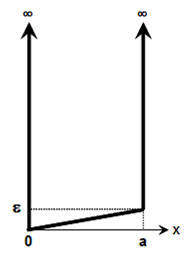
Rigid rotator
The equation below defines the
eigenvalue problem for a two-dimensional, quantum-mechanical, rigid rotator:
-(ħ2/2I)(∂2/∂θ2)ψ(θ)
= Eψ(θ),
where ψ(θ
+ 2π) = ψ(θ).
(a)
What are the energies Ej and wave functions ψj(θ) of
its lowest three energy eigenstates?
(b) A perturbation U = β cosθ
is added to its Hamiltonian. Find
the effect on the ground state energy, to second order in β.
Solution:
Details of the calculation:
(a)
(∂2/∂θ2)ψ(θ)
+ (2I/ħ2)Eψ(θ)
= 0.
ψ(θ) = A exp(imθ), E = ħ2m2/(2I).
where ψ(θ
+ 2π) = ψ(θ) --> m = 0, ±1,
±2, ... .
For m ≠ 0 each energy eigenvalue is two-fold
degenerate. The normalized eigenfunctions corresponding to E = ħ2m2/(2I)
are ψ±m(θ) = (2π)-½ exp(±i|m|θ) and linear
combinations. ψ±m(θ) are eigenfunctions of Lz = (ħ/i)(∂/∂θ)
with eigenvalues ±|m|ħ.
(b)
H0 + U. U = β cosθ.
The ground state ψ0(θ) is not degenerate, E00 = 0.
E10 = <ψ0|U|ψ0>
= (2π)-1∫02π β cosθ dθ = 0.
The first order energy correction is zero.
The second order energy correction for the ground state is
E20 = ∑m≠0
|<ψm|U|ψ0>|2/(E00
- E0m).
∫02π exp(imθ) cosθ dθ = 0 unless |m| = 1.
E20 = |<ψ1|U|ψ0>|2/(E00
- E01) + |<ψ-1|U|ψ0>|2/(E00
- E01)
= |<ψ1|U|ψ0>|2/(-ħ2/(2I)) +
|<ψ-1|U|ψ0>|2/(-ħ2/(2I))
= -(2Iβ2/ħ2)2|(2π)-1∫02π cos2θ
dθ|2
= -(Iβ2/ħ2).
Suppose the Hamiltonian of a rigid rotator in a magnetic field
is of the form
H = AL2 + BLz + CLy,
if terms quadratic in the field are neglected.
Assuming B >> C, use perturbation theory to
lowest non-vanishing order to get appropriate energy eigenvalues.
Solution:
Details of the calculation:
H = AL2 + BLz + CLy, B >> C.
H = H0 + H', H0 =
AL2 + BLz.
The eigenstates of H0 are {|lm>}. H0|lm> = (Al(l+1)ħ2
+ Bmħ)|lm>
The eigenvalues are not degenerate.
The first order corrections are E1lm = C<lm|Ly|lm>
= -(iC/2)<lm|L+- L-|lm> = 0.
We have to find the second order corrections E2lm.
E2lm = ∑l'm'≠lm
C2|<l'm'|Ly|lm>|2/(E0lm - E0l'm')
Ly = -(i/2)(L+- L-)
L±|l,m>
= [l(l+1) - m(m±1)]½ħ|l,m±1>.
<l'm'|L±|l,m>
= [l(l+1) - m(m±1)]½ħ δl,l' δm',m±1.
E2lm = (C2/4)[l(l+1) - m(m+1)]ħ2/(Bħ(m - (m+1)))
+
(C2/4)[l(l+1) - m(m-1)]ħ2/(Bħ(m - (m-1)))
=
+C2mħ/(2B).
The energy eigenvalues to second order are Al(l+1)ħ2
+ Bmħ +
C2mħ/(2B).
Infinite well
A particle of mass m moves in the potential energy function
U(x) = ∞, x < 0, x > a,
U(x) = εx/a, 0 < x < a
where ε is a small perturbation.

Use first-order perturbation theory to find the ground state energy of the particle.
Solution:
A
particle of mass m is in an infinite potential well perturbed as
shown in the figure.
(a) Calculate the first-order energy shift of
the nth eigenvalue due to the perturbation.
(b) Write out the first three non vanishing terms
for the first-order perturbation expansion of the ground state in terms of the
unperturbed eigenfunctions of the infinite well.
(c) Calculate the second-order energy shift for
the ground state.

Solution:
Details of the calculation:
(a)
H = H0 + H'.
H0|Φn> = E0n|Φn>.
Φn(x) = (2/a)½sin(nπx/a), E0n=
n2π2ħ2/(2ma2), n
= 1, 2, 3, ... .
The eigenvalues of H0 are not degenerate.
H'(x) = 0, 0 < x < a/2, H'(x) = U0, a/2 < x < a.
U0 = h2/(40ma2) = π2ħ2/(10ma2).
E1n = <Φn|H'|Φn> = (2U0/a)∫a/2a
dx sin2(nπx/a) = U0/2.
E1n = π2ħ2/(20ma2).
To first order all energies are shifted up by U0/2.
(b) First-order perturbation theory yields for the ket
|ψ1> = |Φ1> + ∑n>1<Φn|H'|Φ1>/(E01
- E0n) |Φn> ,
<Φn|H'|Φ1> = (2U0/a)∫a/2a
dx sin(πx/a)sin(nπx/a)
= (2U0/π)∫π/2π dx sin(x)sin(nx)
= (2U0/π)[sin((n-1)π/2)/(2n-2) - sin((n+1)π/2)/(2n+2)].
<Φn|H'|Φ1> = 0 if n = odd.
<Φ2|H'|Φ1> = -4U0/(3π), <Φ4|H'|Φ1>
= 8U0/(15π).
E01 - E02 = -3π2ħ2/(2ma2).
E01 - E04 = -15π2ħ2/(2ma2).
|ψ1> = |Φ1> + [4U0/(3π)]/[3π2ħ2/(2ma2)]
|Φ2> - [8U0/(15π)]/[15π2ħ2/(2ma2)]
|Φ4> + ...
= |Φ1> + 8/(90π) |Φ2> + 16/(2250π)|Φ4> +
... .
(c) E21 = ∑n>1
|<Φn|H'|Φ2>|2/(E01
- E0n)
= -[4U0/(3π)]2/[3π2ħ2/(2ma2)]
- [8U0/(15π)]2/[15π2ħ2/(2ma2)]
- ...
= -ħ2/(100ma2)[32/27 + 128/3375 + ...] = second-order energy shift for
the ground state.
The second-order energy shift of the ground state is always negative.
A particle of mass m is constrained to move in an
infinitely deep, one-dimensional square well extending from -a to +a.
If this
particle is under the influence of a perturbation H' = -Aδ(x),
where A is a constant and δ(x) is a
delta function at x = 0, calculate the first order corrections to the energy
levels.
What is the condition that A must satisfy if the corrected n* energy
level is to have a negative energy?
Solution:
Let us calculate the first order
energy corrections due to the perturbation.
n = odd:
En1 = -AN2∫-aa cos2(nπx/(2a))δ(x)dx
= -(A/a)
n = even:
En1 = -AN2∫-aa sin2(nπx/(2a))δ(x)dx
= 0.
En* = n2π2ħ2/(8ma2)
- A/a if n = odd. We need A > n2π2ħ2/(8ma)
for En* to be negative.
En* = n2π2ħ2/(8ma2)
if n = even. The perturbation does not change this energy level to first
order.